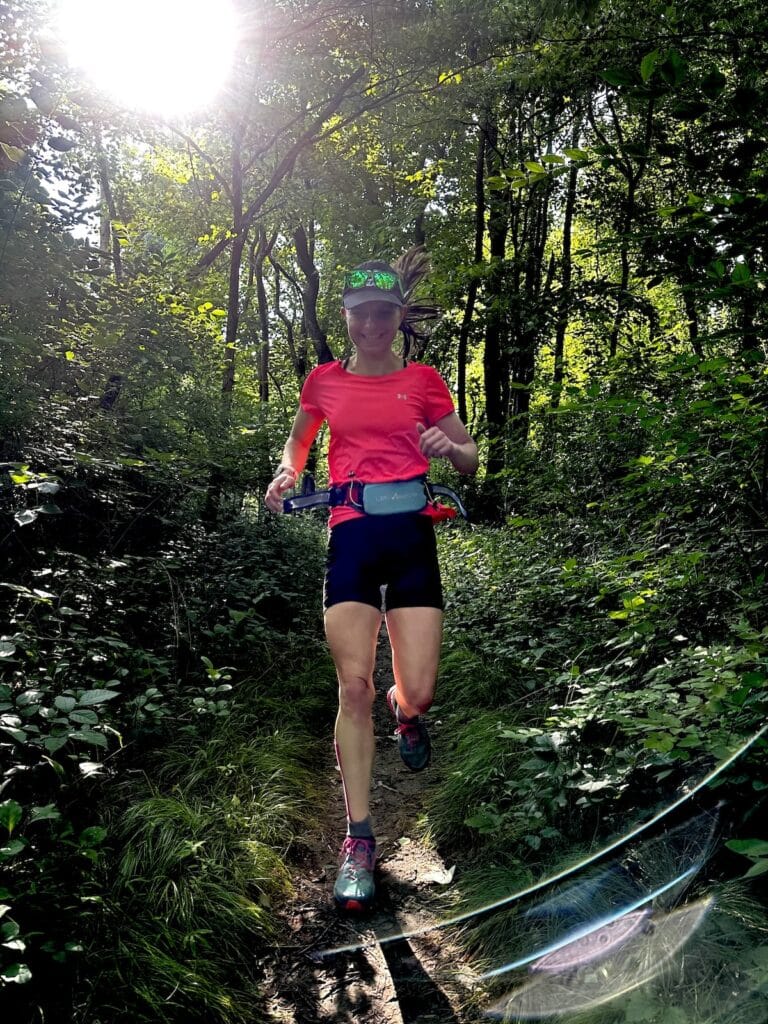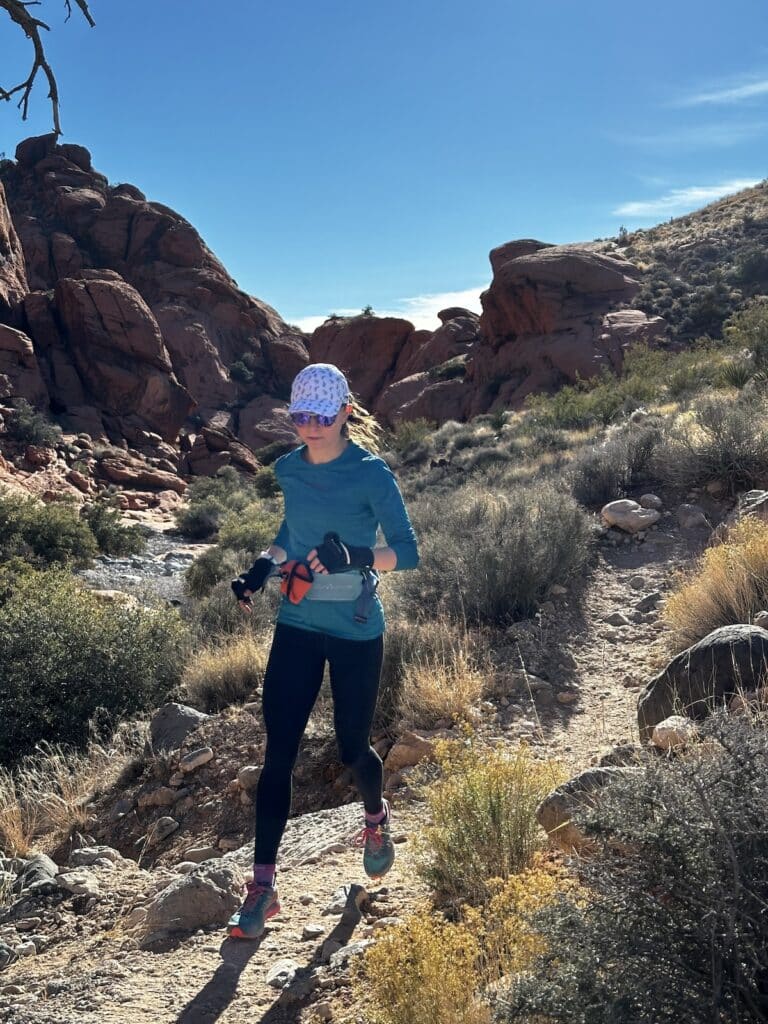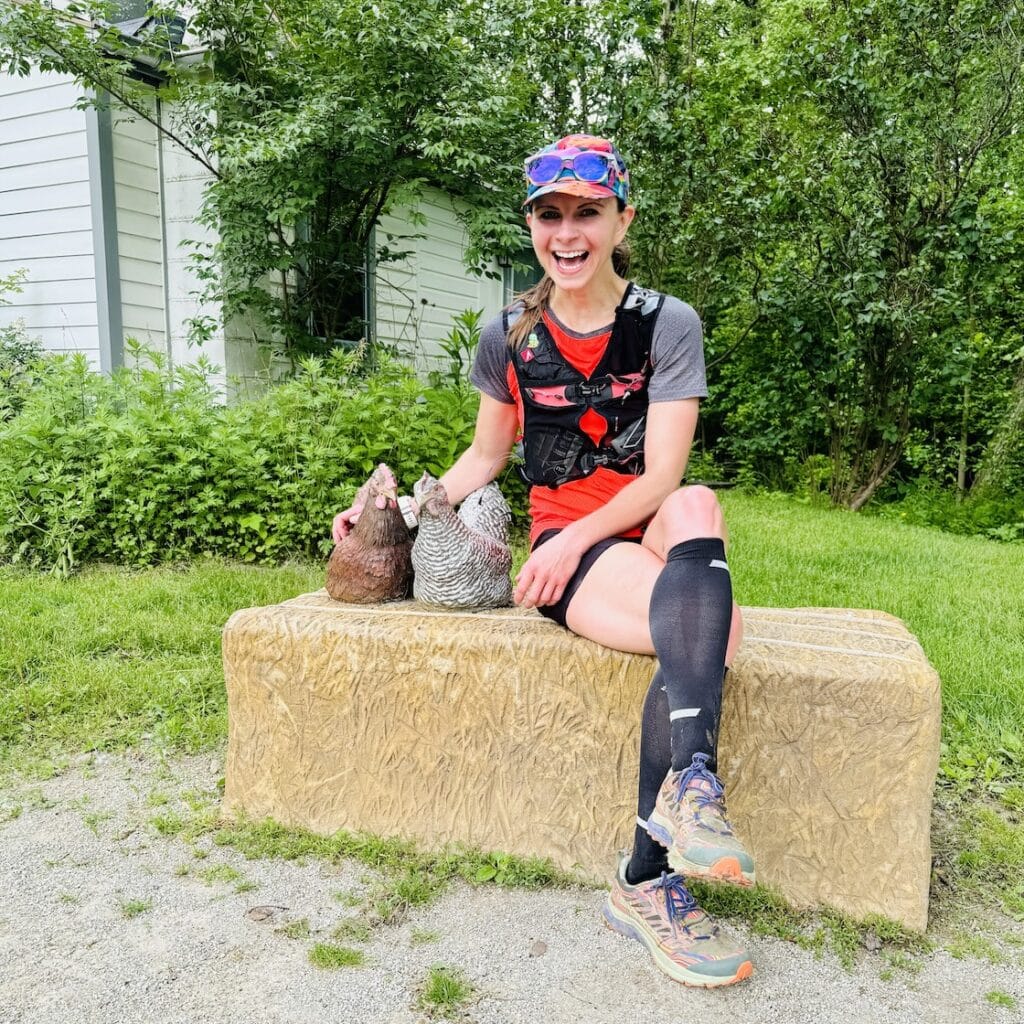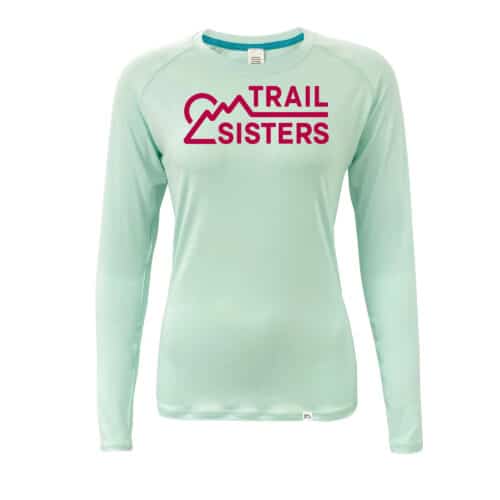Main Menu
Rehabbing Achilles Tendinopathy While Training

Hi there, I’m Courtney! I’ve been a recreational runner since the age of 14, but it wasn’t until 2020 that I discovered my true passion – trail running. I found that the trails were the only place I could run without experiencing debilitating post-concussion symptoms. Since 2020, I’ve completed five 50Ks and one 50-miler, with plans for many more in the future. I was so fascinated by the training theory behind ultrarunning that in 2023 I obtained my UESCA Ultrarunning Coach Certification. Since then, I’ve been working with members of the running community, helping them design training plans tailored to the unique demands of their races. You can find me at Crooked River Coaching.
Share This Article!


By: Courtney Gras
Articles are provided by community members who share their thoughts, experiences, and opinions. The information provided in this article is for educational purposes only and does not substitute for professional medical advice.
This post is for anybody out there who might be dealing with achilles tendon issues. I had a 2+ year journey dealing with this and completed my first 50 miler in 2023 while continuing to rehab my achilles safely. Today, I can run pain-free! I’m incredibly passionate about this topic, the impact it has on runners, and the proper treatment methods for achilles tendinopathy. I wanted to share my training adaptations and lessons-learned for anybody else struggling with these issues too. Spoiler alert: you don’t have to stop running!
First, some terminology
Tendonitis is the inflammation of the achilles tendon and if left untreated for too long, will turn into the chronic version, tendinosis, which is damage to the collagen fibers in the tendon itself. The general term – tendinopathy – is what’s used to cover any issue with a tendon. The biggest thing I learned in my process is that tendons like to stay active! Prolonged rest and large chunks of time off running will not help with the healing process, as healing requires blood flow, which requires movement!
Tip: It’s critical to get an ultrasound to see how bad the damage to your achilles is, as well as the location of the damage before you continue running or start rehab exercises – more on this later!
In this post I’ll dive into my journey: things I tried that didn’t work, things that did work, and how I modified my training plans to accommodate this annoying injury. I hope you walk away full of hope that this will *not* derail your training year!
Note: I’m *not* a doctor, though I’ve spent a ton of time seeing doctors, massage therapists, physical therapists, and most recently, a really knowledgeable physiotherapist. I’m also a UESCA certified ultrarunning coach. So, take this like a conversation with a trail runner friend over a nice cup of coffee, or better yet, a nice cold beer. I hope it’s helpful!
Context
I started trail running in summer 2020 after about 18 years of casual road running. I started running trails for fun with my ‘crazy’ ultra-running friends in fall and heard countless stories of their races, learned their training tips, and signed up for my first 50k in May, 2021 (because why not dive straight in, right?!)
The Stubborn Runner Phase
Late fall 2020 my rapid switch to trails caught up with me, and I started experiencing a burning pain in the back of my left ankle, near the heel, which I later learned was insertional achilles tendonitis.
Tip: you experience pain in the achilles either at the midpoint just above the ankle, or at the insertion point at the heel – the location of the pain is an important factor in your rehab exercises – if you’re doing the wrong exercises for the wrong location, you could be doing more harm than good!
After a few doctor visits and an ultrasound of my achilles I was assured my achilles had no major damage at this point, but my weak calf muscles (soleus muscle specifically) was pulling on everything downstream and causing the inflammation. I ran through that pain and somewhat ignored the PT exercises I was given, also somewhat half-a$$ing my training for the 50k. 🙂 I did finish that 50k, but finished thoroughly broken with a screaming achilles. I know I had to get serious about rehab.
Trial and Error
I took one year ‘off’ from racing ultra-distances and was feeling good enough (so I thought) in November 2022 to sign up for my first 50M, hoping things would continue to improve seemingly on their own (??), though I wasn’t following a real strategy for rehab at this point. I bounced around a number of physical therapists and kept trying things like calf-stretching and other exercises that were simply incorrect for the type of achilles issues I had. It took another year for me to find a physiotherapist that knew how to properly rehab the achilles without requiring me to stop running.
Let’s pause. Things I learned you shouldn’t do
Some things I was told to try by various practitioners turned out to be not so good. Here are some examples:
- Stretching your calves: your achilles doesn’t like to be stretched! While it’s important to keep your calves happy so they’re not adding stress to the achilles, try foam rolling, dry needling and massage instead.
- Anti-inflammatories of any kind: ibuprofen and yes, icing, has been shown to slow the healing process as it stunts your body’s inflammatory response which triggers a hormone that starts healing. You ideally want to let the inflammation do its thing for at least a few hours post-run so your body starts to heal. If you need some pain relief, do it at night. If you have the chronic version, tendinoisis, try to avoid this altogether.
- Resting – yep, I said it! Tendons need blood flow to heal, and in order to keep this issue away you need to strengthen them too. Calf eccentrics (rise up onto your toes then slooooowly lower down) to start, running within tolerable levels (pain level <5/10) with days off running to follow, and progressive loading for both soleus and gastroc are best – do something every day!
- Google-searching exercises: because the rehab exercise prescription changes based on the location and severity of your symptoms, I don’t suggest the “YouTube” solution. It’s best to talk to a PT who works with runners and fully understands this to get an exercise program (and get an ultrasound!).

Leading up to the 50M
I went to a sports doctor who could monitor my achilles via ultrasound throughout training and a new PT based on the recommendation of a local trail-runner friend. In January I hit the PT exercises hard. Hundreds of calf eccentrics each week and lots of single-leg work with the leg press. I also worked on my hips using a band doing clamshells, monster walks, etc. Everything is connected! I continued every single exercise throughout training up to the week before my race. Things were feeling a little better, but far from fixed. I still had a pain level of 5/10 on average on my runs and the morning after…ouch.
At this point I also dove really deep into training theory for ultras and adapted a few plans I found to my unique needs so I could spend less time running, more time cross training to take stress off my achilles. I went as far as to get an ultrarunning coaching certification from UESCA just because I wanted to understand the theory better myself (nerd-alert!). I officially started 50M training 22 weeks out from race day, and happily finished my 50M 40 minutes ahead of my target time in 11:07 (a good time for me!)…after only running 3 days/week and substituting my time-on-feet with cross-training.
The plan that made all this go away
After the 50M I *finally* found a physiotherapist that knew how to treat this issue in runners – hallelujah! I immediately removed back-to-back runs from my training as I learned you need 2-3 days for the collagen to regenerate and your Achilles to heal. I also integrated more isometric calf exercises and harder, weighted exercises overall, as I learned I was plateauing just doing calf eccentrics and not seeing any additional benefit. This was the key to seeing *real* progress.
Despite the fact my achilles damage had progressed to the dreaded tendon-osis vs -itis, my physiotherapist never suggested I stop running. As mentioned earlier, tendons do not like rest, they need to be exercised and strengthened (blood flow stimulated) in order for them to heal. Today, I can happily say that after 8 months of dedicated, progressive rehab I can finally run 100% pain-free, with minimal tightness the morning after my long runs (18 miles+). Once I started proper progressive strengthening exercises I started to see results fast – pain decreases within a few weeks! I had some setbacks, some “bad” weeks, and noticed my symptoms would flare if I was stressed, traveling, or even with hormone fluctuations (yes, that’s a thing!). But today I’m at the final step of the rehab process – I know I need to keep up with exercises to keep it that way.
The keys to rehab were:
- Modifying my training plan so I had a rest day (or two) in between runs
- Get my desired time-on-feet by cross training on elliptical, stairmaster or bike
- Follow a progressive loading plan for my achilles, doing exercises every day I wasn’t running, and doing some exercises pre-run to warm up the tendon. The exercises got progressively harder as my tolerance went up: this is SO important for return-to-running pain free!
- I’d monitor my pain levels during activity closely and modify my training based on these levels: if anything was over a level 3-ish, I would say that activity was not well-tolerated. The pain monitoring continued into the morning after the run as well: if you have an achilles issue, you know you have the worst tightness first thing in the morning. So, if your pain level during the run was a 3, but the morning after it’s a 6, that means that activity was not well-tolerated and you should take some mileage off/cross train more. Following this as my guide for when I could run more was *so* important, I can’t stress this enough. Some pain is ok – and expected early into rehab – but not too much. 🙂
Source: https://pubmed.ncbi.nlm.nih.gov/17307888/
The details: key training adjustments for achilles tendinopathy
When I started training for my 50M in January 2023 the burning pain post long-runs was real. My ankle would “stiffen up” after the long runs, so any prolonged sitting or sleeping made it much worse post-run. I used the following techniques to help with this since.
- Run less (but maintain time on feet): Every single 50M training plan you’ll find has you running 5-6 days/week. I knew my achilles couldn’t handle that, so I adapted my plan such that I was only on trails 3 days a week – the long run on Saturday, the back-to-back Sunday (which I have since removed), and one mid-week run on Wednesdays, when I also did my hill workouts. I wasn’t idle Tuesdays and Thursdays though! These days I’d use a combination of elliptical, stairmaster, and treadmill hiking to get in the equivalent miles and time-on-feet necessary, while also ensuring I kept my HR in the equivalent zone to what I’d see on a run.
- Calf eccentrics are a good start, but may not be enough: I’d suggest talking to a knowledgeable physiotherapist for this, but the basic idea is you rise up onto your toes with both feet then stand on the affected leg and slowly (3-5 seconds) lower your heel down to floor-level. The floor-level part is important based on *which* part of your achilles is damaged. For insertional achilles issues, I learned you don’t want to lower your heel below ground-level (e.g. on a stair), which is suggested for midpoint achilles issues. I did 3 sets of 15 2-3x per day the entire training cycle, except days I was running on trails. HOWEVER, this only got me so far in my rehab, I hit a “plateau” and had to add-in additional weighted exercises and isometrics to see real progress.
- High-drop shoes: I’ve always run in a higher-drop shoes (I wear the La Sportiva Jackal II, which has a 7mm drop). The higher drop takes some load off your achilles.
- Heel lifts/shoe inserts: Towards the latter end of my training my sports doctor suggested I try a ¼” heel lift in my shoes and it made a huge difference (put one in each shoe to prevent other issues, of course 🙂 ). The idea is: the heel lift takes additional load off your achilles – I wish I had done this sooner. I’ve now transitioned back out of the heel lifts (hooray!)
- Apply Voltaren and Arnica Cream to affected area at night (let the inflammation happen earlier in the day – it’s good for you!: Voltaren is a topical NSAID and Arnica cream is also an all-natural pain reliever. I’d apply these to my ankle at night and wrap it in Saran wrap (I know, sounds crazy), but the wrap helps both absorb into the skin. I’d wake up feeling much better. HOWEVER: I learned if your tendonitis has turned into tendinosis, NSAIDs are a bad idea all-around as they can slow the healing process (inflammation is actually a good thing: it tells your body it needs to get to work healing something!). So I only suggest this for some relief overnight, after you’ve allowed the inflammation to just be for a bit.
- Massages and dry needling: I got regular massages and dry needling and have a collection of foam rollers, balls, etc to release my muscles at home too. Keeping your calves loose is key to relieving the strain on your achilles. Balancing dry needling with strengthening is tricky business, but I found the combination of the two helped a lot.
- Collagen supplements. I found a collagen supplement specifically formulated for tendon strength. Now, do I 100% believe this helped and wasn’t just a placebo effect? Ehhh hard to say. But I don’t think supplementing with collagen can hurt, and there are some research studies that show this may be effective.

My training plan today
I completed another 50k in April 2024, and followed this plan (also very similar to what I followed for my 50M). My training plan was a combination of pure trail runs, cross training on elliptical, stairmaster, bike, yoga, and weight lifting. I believe the lifting, specifically addressing my weak areas, was key to my race-day success.
- Saturday long run on trail
- Sunday back-to-back run substitute (no running back-to-backs on a bad achilles!)
- I used a time-on-feet model for Sundays, usually between 1-2 hours on elliptical and/or stairmaster
- Monday active recovery: upper body weights and core + yoga
- Tuesday speed day on trail (hills)
- If my achilles wasn’t feeling great I’d do speed work on an elliptical or do an easy trail run this day
- Wednesday cross training on elliptical//stairmaster/treadmill hiking + leg day
- Thursday medium length trail run
- Friday active recovery: upper body weights and core + yoga
In Summary
If you’re dealing with achilles tendinopathy, I sure do hope this is helpful! I’ve heard from many that this is an issue that may never fully go away, so I still have work ahead of me. The good news is: I’m convinced based on my own experience that you can continue to run and rehab your achilles. You may not be the fastest gal/guy out there, but you can do it safely. I hope you have the same success!

About the Author

Hi there, I’m Courtney! I’ve been a recreational runner since the age of 14, but it wasn’t until 2020 that I discovered my true passion – trail running. I found that the trails were the only place I could run without experiencing debilitating post-concussion symptoms. Since 2020, I’ve completed five 50Ks and one 50-miler, with plans for many more in the future. I was so fascinated by the training theory behind ultrarunning that in 2023 I obtained my UESCA Ultrarunning Coach Certification. Since then, I’ve been working with members of the running community, helping them design training plans tailored to the unique demands of their races. You can find me at Crooked River Coaching.
Share This Article!












4 Responses
Thank you for this article! I am currently rehabbing insertional achilles tendonitis. This article resonates as I was initially doing all of the “things not to do” and am now on a path to recovery with similar adjustments. As a runner without injuries / pains previously, this article was so helpful to ease my frustrations in the long road to healing. Would you be willing to share the collagen supplement that you found that is formulated for tendon strength? Thank you again for your article!
Hi Katie! Thanks so much for the comment. You are definitely not alone on this journey, and I know how frustrating it can be! The collagen supplement I used (and still use!) is by Salt Wrap: https://saltwrap.com/products/collagen-synthesis?_pos=2&_fid=e5a35cb6c&_ss=c&selling_plan=1721532584
I hope this helps with your recovery! Give me a shout if I can help in any other way.
Thank you so much! I will give it a try!
Have a great weekend and happy running!
Hi – great article
I must have won the lottery , I got midpoint on the right and insertional on the left. Had to stop trail running last fall but itching to get back and know that rehab and strength are key
Can you give some examples of rehab exercises for both to highlight the diff
“Tip: you experience pain in the achilles either at the midpoint just above the ankle, or at the insertion point at the heel – the location of the pain is an important factor in your rehab exercises – if you’re doing the wrong exercises for the wrong location, you could be doing more harm than good!?